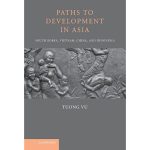Ideology
Vietnam’s Communist Revolution: The Power and Limits of
Ideology.
By Tuong Vu.
New York: Cambridge University Press,
2017. Softcover: 337pp.
Source: Contemporary Southeast Asia , Vol. 40, No. 2, ISEAS @ 50 Special Issue: Young Scholars in Southeast Asian Studies (August 2018), pp. 336-338
Published by: ISEAS – Yusof Ishak Institute
By Huong Le Thu
Huong Le Thu is a Senior Analyst at Australian Strategic Policy Institute and an Associate Fellow at Strategic and Defence Studies Centre, Australian National University. Postal address: 130 Garran Road, Acton, ACT 2601 Australia; email: lethu.huong@anu.edu.au.
What drove the North Vietnamese leadership to fight the most powerful country in the world, the United States? Did their leaders understand what they were up against and what the costs to the nation would be? While Tuong Vu’s book is not about the “Vietnam War” per se, it is this puzzle that drove him to explore
Vietnam’s communist revolution — a rare case of a revolution that succeeded and which has stood the test of time.
Vu takes readers on a journey through the history of Vietnamese communism: from the introduction of communist ideas in the 1920s and 1930s, through to the gradual ideological integration with the Soviet bloc in the 1950s. As the author notes, “Communism was completely alien to Vietnam” (p. 59) — an obvious statement perhaps, but a powerful reminder that Vietnam’s leaders prioritized self-determination before communism’s global revolutionary mission (p. 12). In short, as an ideology, patriotism trumped communism. In the early twentieth century, the Vietnamese Communist Party (VCP) was born “out of the most progressive elements of the Vietnamese Nationalist Party” (p. 71). It is a striking contradiction with the conservative thinking of the Party today.
According to Vu, “Marxist-Leninism built on nationalist frustrations when it entered Vietnam” (p. 16). And because Marxist-Leninist theory did not oppose nationalism, when Vietnam’s nationalist leaders became communists they were not required to renounce their nationalist sentiments. In return, they gained
international brotherhood with fellow communists (p. 17). It is this relationship with other socialist movements that determined Vietnam’s foreign policy, and arguably fate, in the following decades.
The role of ideology became the leading force for the Vietnamese to stand up to the United States and China, making them believe in the seemingly impossible. After the war, ideology played a central role in the governance of the country: 1) it legitimized Party rule of the state and the economy; 2) it supported the VCP’s internal legitimacy and; 3) it linked externally to the solidarity with the transnational network of communist and worker movements.
Throughout the book, Vu demonstrates how the North Vietnamese bought into the mission of internationalism, and how the pride of revolutionary success became the central driver of the country’sforeign policy, especially after Hanoi’s victory over the United States in 1975. “Drunk with pride” (p. 238), the Vietnamese, now united, would pursue a political path that was no longer viable in China— which deviated from Marxist-Leninism to Maoism — as well as the Soviet Union which collapsed in 1991. But the VCP persisted, and despite the adoption of economic reforms in the mid-1980s, revolutionary communism remained at the core of VCP values.
While the communist ideology was the central driver behind the success of Vietnam’s military forces during the Cold War, it also proved to be a weakness. Many irreversible missed opportunities — including normalization of relations with the United States in 1977, which could have had prevented future conflicts with China and Cambodia — occurred because of Hanoi’s stubborn adherence to Marxist-Leninism. Tuong Vu disagrees with the mainstream view that Vietnam was a helpless victim and pawn of the Great Powers during the Cold War. Instead, he argues that North Vietnam was an enthusiastic participant on the ideological frontline of the Cold War because it believed that it was entrusted by history “with the duty to defend this outpost against imperialism” (p. 113). As he shows in Chapter Four in particular, between 1953 and 1960, world peace and proletarian internationalism became more important to North Vietnam’s leaders than the cause of national unification. By that time, a “genuine patriotism” had been transformed into a union between “the love for the motherland with class consciousness” (p. 139). Thus, as Prime Minister Pham Van Dong wrote in 1958: “to be patriotic is to develop socialism, to develop socialism is to be patriotic” (p. 141).
It was a conscious process that socialism was to be integrated into Vietnamese political thinking; it became dogmatic. Vu reminds us that “No Vietnamese had ever questioned patriotism, but socialism had always been controversial” (p. 141). By the 1960s and 1970s, North Vietnam’s socialist identity had been well established and its relations with fellow socialist countries had strengthened. Le Duan — the VCP Secretary General who succeeded Ho Chi Minh — and Mao Zedong famously said that the two nations were like “lips and teeth that lived and died together” (p. 187). Duan pledged that Vietnam would never deviate from the policies of protecting the Soviet Union and China and keeping solidarity with the entire socialist camp and the international communist movement (p. 188). While this sentiment was genuine from the Vietnamese side, as history showed, there was no reciprocal commitment from China. Hanoi’s dedication to the cause was strong and, as Duan understood it, the domino theory meant that a US defeat in Vietnam was necessary to damage America’s global imperialist domination (p. 194). The period 1964–75 made clear that the Vietnamese struggle was not only for independence but was also embedded in the concept of “three revolutionary tidal waves”: the struggle of the socialist camp to defeat the capitalist camp; the struggle of working-class movements against capitalists; and the promotion of revolutions in colonies and neo-colonies to overthrow imperialism (p. 201).
Vu points out that American analysts did not appreciate the “explosive revolutionary potential” of Vietnam and overestimated their ability to defeat North Vietnam by force of arms. Even after the victory in 1975, the Vietnamese sense of mission remained strong. In fact, the pride that Vietnam felt having reunified the country — something that the People’s Republic of China, North Korea and East Germany had all failed to achieve — only fuelled Hanoi’s ambition to be in the vanguard of communist internationalism. As such, Washington was still seen as the most dangerous enemy, even after the war had ended, because it worked to isolate Vietnam in Southeast Asia with sanctions and later gave silent approval for China to invade Vietnam in 1979 and “teach Vietnam a lesson” after Hanoi’s relations with Beijing nosedived (p. 230). The unexpected developments in the Sino-Soviet split, followed by souring Sino-Vietnamese relations, represents the failure of ideology for the Vietnamese. The military mastermind behind Vietnam’s victories against the French and the Americans, General Vo Nguyen Giap, labelled China’s 1979 invasion as “dirty” and “cowardly” and a betrayal of socialist internationalism.
By that point, ideology had become inimical to Vietnam’s national interests: Vietnam became isolated, with powerful enemies both in the capitalist and socialist camps. Vu’s book is a must read for political scientists and those with an interest in Vietnamese politics and history. His explanation of the effect of communist thought on the Vietnamese leadership goes through the Doi Moi era until recent years. Vu charts the evolution of the communist ideology in Vietnam, from a progressive and motivating force to a limiting dogma that blinded Hanoi from the real threats facing the country.








